
P.O.
Box 9021
Wilmington DE 19809 USA
Phone: (302) 529-1876
or toll-free
tours@focusonnature.com
website: www.focusonnature.com

|
P.O.
Box 9021 tours@focusonnature.com website: www.focusonnature.com |
Rare Birds in Brazil
noting some seen during
Focus On Nature Tours
including, among others:
Brazilian Merganser, Cherry-throated Tanager,
Hyacinth Macaw, Forbes' Blackbird,
Harpy Eagle, and Crowned Solitary Eagle
The following list and data was compiled & written by Armas Hill,
using classifications designated by Birdlife International,
with the status of birds as in the most recent update.
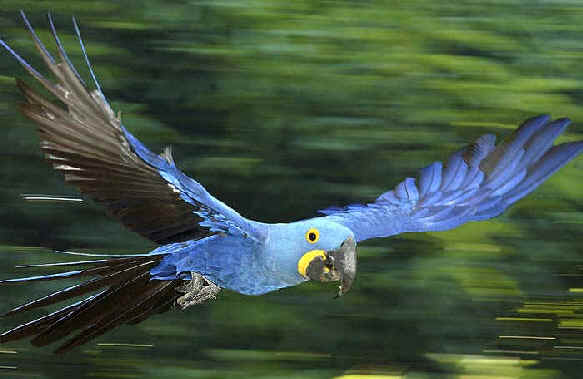
A Hyacinth Macaw in flight
Codes:
(BRe): endemic to
Brazil (BRqe):
quasi-endemic, or nearly endemic to Brazil
Links:
Upcoming FONT Birding & Nature Tours in Brazil Some Highlights from Past FONT Brazil Tours
A
List & Photo Gallery of Brazil Birds, in 4 Parts:
Part #1: Tinamous to Doves
Part
#2: Macaws to Flycatchers
Part #3:
Antshrikes to Woodcreepers Part
#4: Vireos to Grosbeaks
Lists of Birds in Various Areas in Brazil:
Minas Gerais
Mato Grosso & Mato Grosso do Sul
Rio Grande do Sul
Southeast Brazil
Directory of Photos in this Website
![]()
SPECIES OF BRAZIL BIRDS
Classified as: CRITICALLY THREATENED
Belem Curassow Brazilian Merganser
White-collared Kite Purple-winged Ground Dove
Araripe Manakin Kinglet
Calyptura Rio Branco Antbird
Stresemann's Bristlefront
Hoary-throated Spinetail Alagoas Foliage-gleaner Forbes' Blackbird Cherry-throated Tanager
Cone-billed Tanager
Classified as: ENDANGERED
Chestnut-bellied Guan Red-billed Curassow
Dark-winged Trumpeter Hyacinth Macaw
Lear's Macaw Golden Parakeet Golden-tailed
Parrotlet Brown-backed Parrotlet
Red-tailed Amazon Red-spectacled
Amazon Red-browed Amazon
Vinaceous-breasted Amazon White-winged Nightjar
Hook-billed Hermit Varzea Hermit
Buff-throated Purpletuft Banded Cotinga
White-winged Cotinga Wied's Neopelma
Kaempfer's Tody-Tyrant Atlantic Royal
Flycatcher Restinga Antwren Black-hooded Antwren
Fringe-backed Fire-eye Marsh Tapaculo Cipo Canastero
Bahia Spinetail Scaled Spinetail
Saffron-cowled Blackbird
Yellow Cardinal
Classified as: VULNERABLE
Gray Tinamou Lesser Nothura White-crested Guan Blue-throated Piping Guan
Black-fronted Piping
Guan Black Curassow Wattled
Curassow Southern Rockhopper Penguin
Macaroni Penguin White-chinned Petrel Agami
Heron White-necked Hawk Crowned Solitary Eagle
Rufous-faced Crake Olrog's Gull Ruddy
Pigeon Sapphie Quail-Dove Golden-capped
Parakeet
Crimson-bellied Parakeet Pearly Parakeet
Blue-throated Parakeet Scarlet-shouldered Parrotlet
White-bellied Parrot Vulturine Parrot
Festive Amazon Yellow-faced Amazon
Blue-bellied Parrot
Scaled Ground-Cuckoo Dot-eared Coquette Three-toed Jacamar Black-girdled
Barbet
White-bellied Piculet Opal-crowned Manakin
Gray-winged Cotinga Black-headed Berryeater
Cinnamon-vented Piha Bare-throated Bellbird Black-capped Piprites
Buff-breasted Tody-Tyrant
Fork-tailed Tody-Tyrant Sao Paulo Tyrannulet Black-and-white Monjita
Cock-tailed Tyrant
Rondonia Bushbird White-bearded Antshrike Plumbeous Antvireo
Salvadori's Antwren
Unicolored Antwren Guianan Streaked Antwren Band-tailed Antwren
Ash-breasted Antbird
Black-tailed Antbird Bare-eyed Antbird Striated Softtail
Pink-legged Graveteiro
Canebrake Groundkeeper
Uniform Woodcreeper Mato Grosso Woodcreeper
Hoffmann's Woodcreeper
Ochre-breasted Pipit Pearly-breasted Conebill Black-masked Finch
Cinereous Warbling-Finch
Temminck's Seedeater Buffy-fronted Seedeater
Classified as: NEAR-THREATENED
Solitary Tinamou
Great Tinamou White-throated Tinamou
Yellow-legged Tinamou
Gray-legged Tinamou Black-capped Tinamou
Greater Rhea Crestless Curassoe
Marbled Wood Quail Orinoco Goose Magellanic
Penguin Black-browed Albatross
Zigzag Heron Orange-breasted Falcon
Gray-bellied Hawk Mantled Hawk Harpy Eagle
Crested Eagle Ornate Hawk-Eagle Blue-winged
Macaw Black-capped
Parakeet
Caica
Parrot Orange-cheeked Parrot Bald Parrot
Kawall's Amazon Rusty-barred Owl
Bahian Nighthawk
Long-trained Nightjar Sickle-winged
Nightjar Saw-billed Hermit
Hyacinth Visorbearer Red-necked Aracari
Saffron Toucanet Mottled Piculet Guianan
Piculet
Yellow-browed Woodpecker Swallow-tailed Cotinga
White-tailed Cotinga Black-and-gold Cotinga
Hooded Berryeater Hangnest Tody-Tyrant Eye-ringed
Tody-Tyrant Gray-capped Tyrannulet
Sharp-tailed Grass
Tyrant Gray-backed Tachuri Southern Bristle
Tyrant Oustelet's Tyrannulet
Serra do Mar Tyrannulet
Chapada Suiriri Olive-sided Flycatcher Castelnau's Antshrike
Spot-breasted Antvireo
Brown-bellied Antwren Rufous-tailed Antbird
Ochre-rumped Antbird
Rio de Janeiro Antbird
Guianan Warbling Antbird White-lined Antbird White-breasted Antbird
Spotted Bamboowren
Slaty Bristlefront Brasilia Tapaculo White-breasted Tapaculo Campo Miner
Araucaria Tit-Spinetail Long-tailed Cinclodes
![]()
Species in Brazil classified as CRITICALLY THREATENED:
1 BELEM
CURASSOW ______ MT
(BRe)
Crax pinima
Crax pinima, which has been called "Natterer's Bare-faced
Curassow", was conspecific with Crax fasiolata
(above).
As of 2014: A tiny captive population of Crax pinima exists, but
there have been no confirmed records of it in the wild since 1978.
According to Birdlife International, "Any remaining wild population
must be extremely small, and is likely to still be declining."
Thus, now their classification of "critically endangered".
Crax pinima
has been restricted to Maranhao and Para in northeastern Amazonia, therefore
being a Brazilian endemic.
It is said now to be extinct in around Belem, in Para.
It may survive in western Maranhao at the Reserva Biologica do Gurupi and in
nearby areas.
The species was not found recently during extensive fieldwork around
Paragominas in eastern Para (2003)>
During other even extensive fieldwork in Para from 1998 to 2009, the only
reports came from local people who said that the species occurs in very low
numbers in the Agropalma Group Forrestal Reserves in Tailandia, where it was
said to be even more rare than Mitu tuberosum.
In 2009, 5 individuals (3 females and 2 males) were seized in illegal trade
and were sent to a conservation breeding
center.
A female Belem Curassow, or "Nattterer's Bare-faced Curassow" as
it was known at the time, was seen during a FONT tour in the 1990s, along
the riverbank of the Rio Cristalino, near Alta Floresta, in northern Mato
Grosso, Brazil.
2 BRAZILIAN MERGANSER
______
MN (BRqe or
now BRe)
Mergus octosetaceus
The very rare BRAZILIAN
MERGANSER has been seen during 6 FONT tours in Brazil: in March 1997, October 1998,
August 2002, October 2003, September 2006, and March 2008.
Each time, our sightings have been in a remote
part of western Minas Gerais.
Recent estimates have put the population of the species at only about 100 pairs. Some say, however, that's too high a number. With large territories, and
favoring remote areas, the Brazilian Merganser can be a hard bird to find.
The range of the bird has included southeast Brazil, northeast Argentina, and
adjacent Paraguay. It's probably now extinct in Paraguay, and may be so in
Argentina (where the population has been critically small).
Actually, in the
mid-20th Century, the species was thought to be extinct. It was
re-found in 1948. Now, just over 50 years later, this rarity is still "too
close" to extinction.
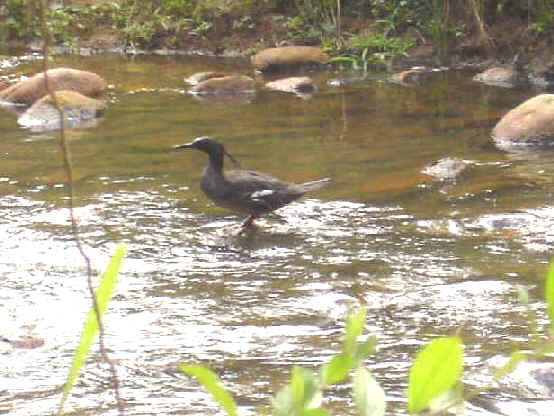
The very rare Brazilian Merganser in Minas
Gerais, 2006.
A pair was seen during the FONT tour in September of that year.
There have been
sightings during FONT tours in Minas Gerais
during 6 different years.
(Photo courtesy of Renilda Dupin)
3 WHITE-COLLARED KITE (also called FORBES' KITE) ______
(BRe)
Leptodon forbesi
The White-collared Kite is a mid-sized that occurs in the states of
Alagoas and Pernambuco in northeastern Brazil, where it inhabits humid forests
below 600 meters above sea level.
It is one of the most endangered raptors in the world, with a very limited range
in which there has been an ongoing destruction of its forest habitat.
But Leptodon forbesi
has apparently been rare fro years. The species was described in 1922
by H.K. Swann from a single specimen collected by W. A. Forbes in 1882 in
Pernambuco.
That specimen is in a natural history museum in England (in Tring). It was
thought by some to be an aberrant-plumaged (perhaps immature) Gray-headed
Kite, Leptodon cayanensis, but more
recently was recognized as a valid species by others.
In 1987, a pair was collected in Alagoas, and another female of unknown age was
also collected, elsewhere in Alagoas, although no detailed descriptions or
photographs of those specimens were published. It was stated, at that time, that
Leptodon forbesi was not an abnormal
immature of Laptodon cayanensis.
In all only 5 museum specimens of this enigmatic species are known. In addition
to the four just mentioned, there is one in the zoological museum at the
University of Sao Paulo, in Sao Paulo.
Still, today, little is known about the White-collared Kite in life,
regarding its morphology, plumage variation, ecology, and geographical range.
4 PURPLE-WINGED GROUND DOVE ______
MN
(BEqe)
Claravis godefrida
The rare Purple-winged Ground was seen during the FONT tour in Minas
Gerais, Brazil in October 2009 in the area of Caraca.
The species at that time was classified as endangered.
Its decline has continued since then, with (as of 2012) the reclassification of
it as being critically endangered.
The population has been suspected to be declining at a rate of up to
about 20 per cent during 10 years, along with habitat loss within the species'
highly restricted range. With the patchy nature of a preferred habitat of bamboo
stands and with the impact of habitat fragmentation, the species may well be
declining at a more rapid rate.
The range of the Purple-winged Ground Dove has been from Bahia south
through eastern Brazil to rarely Paraguay and northeastern Argentina.
It inhabits humid Atlantic forest, with apparently a preference for edge
habitats in rather hilly, broken terrain. It was at such a place that we saw it
in October 2009.
5 ARARIPE MANAKIN ______ (BRe)
Antilophia bokermanni
Antilophia bokermanni
was first described as recently as 1998. Its known range is extremely
small, occurring at just a few locations on the northeastern slope of the
Chapada do Araripe in the southern part of the Brazilian state of Ceara.
Its estimated population is about 800 individuals, is an area of suitable
habitat of only 28 square kilometers.
In January 2012, a new and unexpected locality for the Araripe Manakin
was discovered, in dense forest on the top of the Araripe Plateau, in an area
that has been protected as a national forest (known as FLONA). 10 breeding
territories were found in that small area of just 1 kilometer by 30 meters.
About 5 similar small areas of such habitat occur on the plateau. Even though
small, it does mean that the distribution and size of the bird's population is
slightly greater than previously
thought.
6 KINGLET CALYPTURA ______
(BRe)
Calyptura cristata
The little Kinglet Calyptura is a bird that has been in the
family Cotingidae, and is believed to be closely related to the
also-small purpletufts.
It is very rare, so much so that it appears to be on the brink of extinction.
After an absence of sightings for over a century, the Kinglet Calyptyra
was rediscovered in late October 1996, when two birds were observed on the
slopes of Serra dos Orgaos, north of Rio de Janeiro. Those birds were seen
several mornings, but unfortunately they proved to be just a tantalizing glimpse
before the species once more lapsed into obscurity.
Long lost, and dramatically re-found, the Kinglet Calyptura has since
been lost again.
In February 2006 (ten years after the 1996 sightings), a single bird was
reported near Ubatuba in Sao Paulo state. That sighting was not confirmed.
It seems that the Kinglet Calyptyra occurs at varying altitudes, but
perhaps it is most likely to be found between 200 and 1,000 meters above sea
level in humid forest canopies, where it would forage on insects, seeds, and
fruits including mistletoes.
Even though the species is, as noted here, extremely rare, if it still exists,
it may not have been in the past, as there are a number of museum
specimens.
7 RIO BRANCO ANTBIRD ______ (BRqe)
Cercomacra carbonaria
8 STRESEMANN'S BRISTLEFRONT ______
(BRe)
Merulaxis stresemanni
Until 1995, the Stresemann's Bristlefront, a reclusive tapaculo, was
known from only two specimens: the type-specimen collected near Salvador in the
1830s, and a second taken near Ilheus in 1945 in coastal Bahia.
There was another, third specimen, of unknown provenance, that was found
subsequently to be in a European museum in Berlin, having been seemingly
collected in the "early 19th Century".
The re-discovery in 1995 was of a single bird, tape-recorded and photographed
near a place called Una in Bahia. Despite searching, there have been no
subsequent findings of the bird at that locality.
But the species has been found since in the Jequitinhonha Valley in Minas Gerais,
near the border with Bahia, where it was in a strip of humid valley forest, much
of which had been cleared for
agriculture.
9 HOARY-THROATED SPINETAIL ______
Synallaxis kollari
10 ALAGOAS FOLIAGE-GLEANER ______
(BRe)
Philydor novaesi
11 FORBES' BLACKBIRD ______
MN (BRe)
Curaeus forbesi
The Forbes's Blackbird has been considered a critically
endangered species as it has a very small total population actually comprised of
very small subpopulations in the Brazilian states of Alagoas, Pernambuco, and
Minas Gerais. Thus the rare of this rare Brazilian endemic is severely
fragmented in the eastern part of the country.
Being all-black, without any really distinctive features other than a slender
bill and a unique voice, the most notable aspect of the bird is its rarity.
The small numbers (about an estimated 150 birds at one time said to be in
Alagoas, and about 40 at most in one area of Minas Gerais) has made the
Forbes's Blackbird a rather mysterious "phantom-like"
species, not often seen.
We were fortunate to see 3 Forbes's Blackbirds during the FONT tour in Minas
Gerais, not far from Serra do Cipo, in May 2011.
The birds, at about 4pm, were in the tops of palm trees in the valley of a
small river. Their slender bills and recognizable call were well noted before
they flew away from us.
12 CHERRY-THROATED TANAGER
______
ES (BRe)
Nemosia rourei
The Cherry-throated Tanager
is one of the rarest birds ever seen during any FONT tour, anywhere in the
world.
Our sighting was on October 9,
1998 in the Brazilian state
of Espirito Santo,
just east of Minas Gerais.
The attractive male
was seen well that day by everyone in our group
(ours was the
first birding group EVER to see the
species). 6 hours of searching
and waiting were worth it. Two birds of the species were in a moving mixed
species flock that we
encountered. That flock was seemingly led by the vocal Eastern Sirystes.
The Cherry-throated Tanager is one of
the least-seen bird species
in the world. In the 19th
Century, it was known only from a lone specimen in a European
museum. That bird was collected in 1870 in the area of Muriae, in Minas
Gerais state, along the Paraiba River.
In the 20th century, the species was sighted once,
in 1941, in Espiritu Santo (at Jatiboca), prior to
its very exciting
re-discovery by Brazilian
ornithologists shortly before our tour in 1998. We were most grateful to have
been given permission to enter private land (and to stay overnight there), and to have the great
cooperation of the local biologists, enabling us to see Nemosia rourei, the
Cherry-throated Tanager
as we did.
13 CONE-BILLED TANAGER
______ (BRe)
Conothraupis mesoleuca
The Cone-billed Tanager has been one of the more-famous of the
"lost bird species of South America", with others including the Kinglet
Calyptura, the Blue-eyed Ground Dove, and the Cherry-throated
Tanager (all of these noted above).
In August 1938, a doctor (Dr. A. Vellard), travelling through Mato Grosso in
Brazil, gathered a small collection of birds typical to the region. He shot and
stuffed a few dozen species that he encountered. Later, he showed his skins to a
prominent French ornithologist (Berlioz), who realized that one of them - a
black bird with a white belly, and with a stout and conical beak - was a
"new species". The bird was then given the common name "Cone-billed
Tanager", and at first it was put into its own genus, Rynchopthraupis.
Later, scientists decided that it was similar to another better-known South
American bird, the Black-and-white Tanager of Peru and Ecuador, and it
was shifted to the genus Conothraupis, where the bird has remained.
The 1938 specimen was collected in dry forest habitat near a place named Juruena.
60 years later, in 2004, the Cone-billed Tanager was re-discovered,
seen again fro the first time since the single specimen had been initially
found.
In October 2004, a Brazilian ornithologist (Dante Buzzetti) visited the Emas
National Park, in south-central Brazil, following up a possible sighting the
previous year by a Brazilian bird guide (Braulio Carlos). (Note: Braulio has
on occasion been with us on FONT tours in Brazil.)
At dawn at Emas (in October 2004), Buzzetti heard a bird call he did not
recognize. His playing of that call on a tape recorder attracted a medium-sized
brown bird that he was unable to identify. A few days alter, he heard a
melodious song and again using playback, it brought in a male Cone-billed
Tanager.
Later that day, Buzzetti was able to confirm that the brown bird that he had
earlier seen was a female Cone-billed Tanager, the first ever to be seen.
The following month, Buzzetti and Carlos together, filmed what were presumably
the same pair of birds. Unlike published illustrations (all based on the single
museum specimen of 1938), in life the bill of the Cone-billed Tanager
was strikingly pale, rather than black.
Since 2004, Cone-billed Tanagers have been found again in the Emas
National Park. In late 2005, at least 3 birds were found there in gallery
forest.
Species in Brazil classified as ENDANGERED:
14
CHESTNUT-BELLIED
GUAN ______
MT (BRe)
Penelope ochrogaster
15 BLACK-FRONTED
PIPING GUAN ______ SE
(BRqe)
Pipile jacutinga
16 RED-BILLED
CURASSOW ______ (BRe)
Crax blumenbachi
17 DARK-WINGED TRUMPETER ______
AF (BRe)
Psophia viridis
18 HYACINTH MACAW
______ MS MT (BRqe)
(also another photo at the top of the file)
Anodorhynchus hyacinthinus

A Hyacinth Macaw
photographed during a FONT tour
The Hyacinth Macaw is the largest parrot in the world. During the 20th Century,
it declined greatly due to trading and hunting. In the 1980's, there was a
massive illegal trade, with at least 10,000 birds taken from the wild. 50 per
cent of those were destined for the Brazilian market. In 1983-84, over 2,500
were flown out of Bahia Negra, Paraguay.
Currently, some 2,500 to 5,000 wild birds are estimated as remaining in the
wild, with the vast majority in Brazil, mostly in the Pantanal region. A few
still occur in easternmost Bolivia and northeast Paraguay.
Nesting is during July-December in large tree cavities and on cliffs. Two eggs
are usually laid, but only one normally fledged.
The Hyacinth Macaw has been seen during every FONT tour in Mato Grosso and Mato
Grosso do Sul.
Other similar macaws in Brazil and in nearby South America have, unfortunately,
become extinct, notably the GLAUCOUS MACAW and the SPIX'S MACAW.
The GLAUCOUS MACAW occurred formerly in southern Brazil, particularly in western
Rio Grande do Sul, and in adjacent Argentina and Uruguay, and apparently in
southern and eastern Paraguay.
The SPIX'S MACAW is now extinct in the wild. In the 1990's, one individual
remained in interior northeast Brazil. No longer. The initiatives to provide
effective protection for the last wild birds failed. Endeavors at establishing a
captive-breeding program using stock held in private collections around the
world (perhaps totaling no more than 20 birds) have been unsuccessful.
19 LEAR'S MACAW (also called INDIGO MACAW) ______
(BRe)
Anodorhynchus leari
20 GOLDEN PARAKEET ______
Guarouba cuarouba
21 GOLDEN-TAILED PARROTLET ______
Touit surdus
22 BROWN-BACKED PARROTLET ______
Touit melanonotus
23 RED-TAILED AMAZON ______
SE (BRe)
Amazona brasiliensis
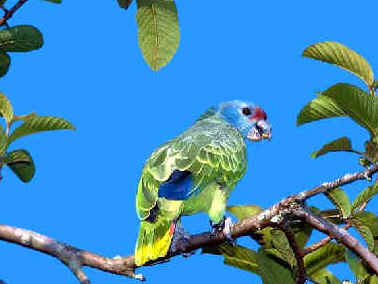
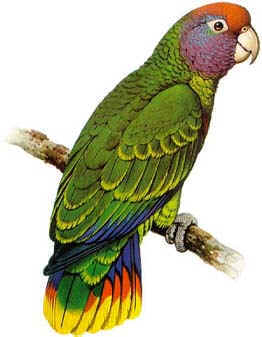
24 RED-SPECTACLED AMAZON ______
RS
(BRqe)
Amazona pretrei
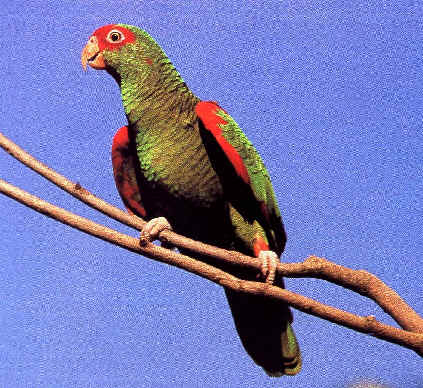
The Red-spectacled Amazon has a small range in southern Brazil and northeast
Argentina (and possibly also in Uruguay & Paraguay). It is closely
associated with Araucaria-dominated forest. Recently, its population has
seriously declined. A comparison of population estimates in 1971 and 1997
indicate that the decline of the species has been at a rapid rate of equivalent
to 22% in 10 years.
The Red-spectacled Amazon has been seen during FONT tours in Rio Grande
do Sul.
25 RED-BROWED AMAZON
______ (BRe)
Amazona rhodocorytha
26 VINACEOUS-BREASTED
AMAZON ______
MN RS SE
(BRqe)
Amazona vinacea
27 WHITE-WINGED NIGHTJAR ______
Eleothreptus candicans
28
HOOK-BILLED HERMIT ______ (BRe)
Glaucis dohrnii
29 VARZEA PICULET ______
Picumnus varzeae
30
BUFF-THROATED PURPLETUFT ______
SE (BRe)
Iodopleura pipra
The Buff-throated Purpletuft is a small bird, just over 3 inches in length, and
a member of the cotinga family. It occurs at only a very few places in a
severely fragmented range in eastern Brazil. During FONT tours, we've seen it
only in the area of Ubatuba, near the seacoast in Sao Paulo state. In that area,
our sightings have been at borders of humid forests, secondary woodland, and
cacao plantations such as Fazenda Capricorno.
The bird tends to perch on high exposed branches. There is some evidence that it
may be associated with a single species of a tall, fine-leaved deciduous tree
which is locally common and often supports clumps of mistletoe. The bird feeds
primarily on berries, particularly those of mistletoe, supplemented by
anthropods.
31 BANDED COTINGA
______ (BRe)
Cotinga maculata
32 WHITE-WINGED
COTINGA ______ (BRe)
Xipholena atropurpurea
33 WIED'S NEOPELMA (was called WIED'S
TYRANT-MANAKIN) ______ (BRe)
Neopelma aurifrons
34
KAEMPFER'S
TODY-TYRANT ______ (BRe)
Hemitriccus kaempferi
35 ATLANTIC ROYAL FLYCATCHER ______
SE
(BRe)
Onychorhynchus swainsoni
36 RESTINGA ANTWREN ______ SE
(BRe)
Formicivora littoralis
A recent study (published in 2011) of morphometric,
vocal and plumage analyses indicated that Formicivora
littoralis, the Restinga Antwren, lacked characteristics
to differentiate it from the Serra Antwren, Formicivora
serrana. And so it recommended that the two be conspecific, with
littoralis as a subspecies of Formicivora
serrana.
The Serra Antwren, a Brazilian endemic, and now classified as a species
of "least concern" was described in 1929 from the Brazilian state of
Minas Gerais.
Subspecies F. s. interposita and F.
s. littoralis were described in the late 1980s. from specimens
taken in the state of Rio de Janeiro (at two different locations).
Two years later, in 1990, F. s. littoralis
was elevated to species status and given the vernacular name of Restinga
Antwren.
Formicivora (serrana) littoralis
lives in a habitat known as "restinga" that is a beach-scrub
habitat rich in cacti and bromeliads on sand dunes, and in other scrub
vegetation on coastal hillsides.
The birds usually forage in pairs, remaining close to the ground in dense
thickets.
The bird has a highly restricted range around Cabo Frio in Rio de Janeiro state.
Both the Serra Antwren and the Restinga Antwren have been seen during FONT
tours. The Serra Antwren in the states Minas Gerais and Rio de
Janeiro. The "Restinga Antwren" in Rio de Janeiro
state.
37 BLACK-HOODED ANTWREN ______
SE (BRe)
Formicivora erythronotos
Only in a very limited area of southeastern Brazil, the Black-hooded Antwren is
very rare. For years, it was only known from Nova Friburgo (north of the city of
Rio de Janeiro), where it was feared extinct, due to habitat destruction, and
with the last reliable record during the second half of the 19th Century.
However, it was recently re-discovered, in 1987, in a secondary swampy wooded
area near the mangrove line at sea level along the southern coast of Rio de
Janeiro state.
The rare
Black-hooded Antwren has been found during FONT tours at the appropriate
locality in Rio de Janeiro state.
38 FRINGE-BACKED FIRE-EYE ______
(BRe)
Pyriglena atra
In 2011, with efforts by the Brazilian Institute for Biodiversity
Conservation, two private nature reserves were created in the state of Bahia
to help and protect the endangered Fringe-backed Fire-eye, a bird that is
a symbol for conservation of the coastal Atlantic Forest.
The two new reserves (Olho-de-FogoRendado, 103 hectares and Curio, 13 hectares)
are both in the municipality of Sao Sebastiao do Passe, in a narrow belt of
Atlantic Forest along the north coast of Bahia.
The global geographic range of the Fringe-backed Fire-eye is about 5,000
square kilometers, and thought to be declining due to loss of the bird's habitat
which is lowland forest with undergrowth.
The species has been found in forest fragments of around 50 hectares, but it has
been found to have disappeared within 2 years at one locality that was reduced
from almost 200 hectares to 40 hectares.
Remaining forest fragments have become smaller and more isolated.
39 MARSH TAPACULO (has also been
called TALL-GRASS WETLAND TAPACULO) ______ (BRe)
Scytalopus iraiensis
The Marsh Tapaculo was first sighted in April 1997 in wetlands beside the Irai
River near Curitiba in southern Brazil.
Until recently, it was known to be at about two dozen sites in eastern Parana
and Rio Grande do Sul (Brazilian states), but it has since also been found in
the highlands of Minas Gerais - far north of its previously known range.
Recently discovered birds in Mians Gerais have been, among other places, in the
national parks of Serra do Cipo and Serra de Canastra, and in the reserve at
Serra do Caraca.
40 CIPO CANASTERO ______
MN
(BRe)
Asthenes luizae
The Cipo Canastero was
discovered only as recently as 1985 in the Brazilian state of Minas Gerais, where it is very localized.
When it was
initially found, it was quite a surprise as all other canasteros occur
much further west in South America, mostly in Andean
habitats.
We've seen the Cipo Canastero during nearly every FONT tour in Minas
Gerais.
The range of this species is but a dot on a Brazilian map, where its habitat is
a limited area of rocky outcrops, and associated dry vegetation.
Also occurring there are 2 other notable Brazilian endemics, both rare, but not
as rare as the canastero. These other two species, designated as
"near-threatened" by Birdlife International, are the Gray-backed
Tachuri (a flycatcher) and the Hyacinth Visorbearer (a hummingbird). Both have
been seen during every FONT tour in the
area.
41 BAHIA SPINETAIL ______
(BRe)
Synallaxis whitneyi
42 SCALED SPINETAIL ______
Cranioleuca muelleri
43 SAFFRON-COWLED BLACKBIRD ______
RS
Xanthopsar flavus
44 YELLOW
CARDINAL ______ RS
Gubernatrix cristata
The Yellow Cardinal occurs in far-southern Brazil in Rio
Grande do Sul and in adjacent Uruguay.
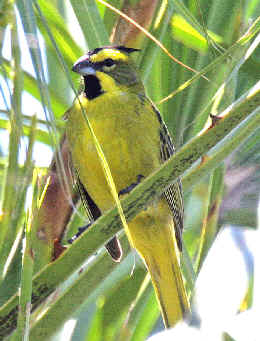
The Yellow Cardinal
Species in Brazil classified as VULNERABLE:
45 GRAY TINAMOU ______
MT
Tinamus tao
46 LESSER NOTHURA ______
MN
Nothura minor
47 WHITE-CRESTED GUAN ______
Penelope pileata
48 BLUE-THROATED PIPING-GUAN ______
AF
MS MT
Pipile cumanensis
49 BLACK CURASSOW ______
Crax alector
50 WATTLED CURASSOW ______
Crax globulosa
51 SOUTHERN ROCKHOPPER PENGUIN ______ (rare in Brazil in oceanic
waters off Rio Grande do Sul)
Eudyptes chrysocome
52 MACARONI PENGUIN ______ (rare in Brazil in oceanic
waters off Rio Grande do Sul)
Eudyptes chrysolophus
53 WHITE-CHINNED PETREL ______ RS
Procellaria aequinoctialis
54 AGAMI HERON ______
AF
AM MT
Agamia agami
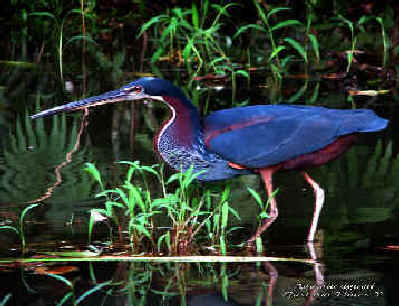
Agami Heron
55 WHITE-NECKED HAWK ______ SE
(BRe)
Leucopternis lacernulata
56 CROWNED SOLITARY EAGLE ______
MN MT
Harpyhaliaetus coronatus
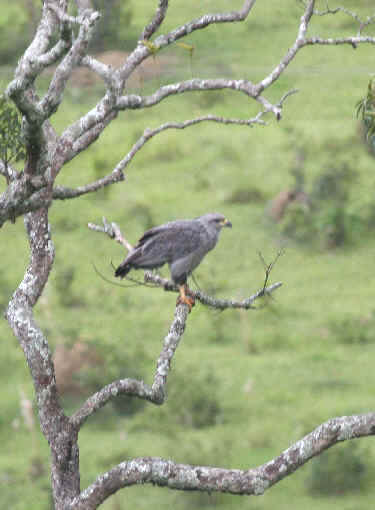
A Crowned Solitary Eagle photographed
in the Brazilian state of Minas Gerais,
during the FONT tour in March 2008.
The Crowned Solitary Eagle is a large, gray bird, occurring sparsely over a large
range mostly in Brazil, but also in Bolivia, Paraguay, and Argentina.
In its big
geographic range of over 3 million square kilometers, this rare bird has been
found at about a hundred localities. But a number of those places, however,
relate to sightings back in the 19th Century.
The species is classified by Birdlife International as "vulnerable"
because "it occurs at very low densities ... in fragmented habitat"
and because "the severity of threats strongly suggest a significant and
continuing decline".
Birdlife International suggests that the total population of the bird is
somewhere between 2,500 and 10,000 individuals.
However, others say that surely such an estimate is too high for a species which
is so thinly scattered and almost everywhere rare or, at best, scarce. A total
of just 1,000 breeding birds (500 pairs) would give an average density over the
entire range of 1 pair in 6,000 square kilometers (that would be 75 x 80
kilometers). The pattern of current, or recent, sightings does not indicate that
many birds. So, even though classified as "vulnerable", the species
may well be more so than others in that category.
Juveniles are said to remain with their parents for several years. Breeding is
less than annual. Birds have a large home range.
The Crowned Solitary Eagle can be described as indolent, sluggish, and partially
crepuscular, as they most actively feed at dusk and dawn. Their favored prey are
skunks and armadillos, animals that are themselves mostly crepuscular.
Population densities are lower in the chaco and cerrado habitats than in rich
grasslands.
The spread of agriculture, with burning, mechanization, and pesticides, and
intensive cattle-raising continue to destroy suitable lightly wooded habitats
and natural grasslands throughout much of the bird's range. Forestation of
grasslands with eucalyptus is further affecting foraging areas. The species is
also hunted. And so, with the combination of these factors, the decrease
continues.
Adults have a long, occipital crest. Hence, "crowned" in its name. The
species is now called the Crowned Solitary Eagle as there is another large
raptor called the Crowned Eagle in Africa.
The Crowned Solitary Eagle and the more-northerly Montane Solitary
Eagle (a
black, not gray, bird, formerly
called the Solitary Eagle) are the only two members of their genus.
Male and female Crowned Solitary Eagles are similar. Females only average about
3 per cent larger.
The Crowned Solitary Eagle is not a "true eagle". It is a buteonine.
But, regardless as to how it is classified, it is large. Of the 100 raptors in North and
South America, only 6 have larger wingspans. In that sense, only the Andean and
California Condors, the Bald and Golden Eagles, the Harpy
Eagle, and the King Vulture are bigger. In South America, only 3 species of raptors have larger
wingspans than the Crowned Solitary Eagle.
In terms of length, only 7 North & South American raptors are larger, with
the Crested Eagle added to 6 species just noted as bigger than the Crowned
Solitary Eagle.
93 (out of 100) species of American raptors have smaller wingspans than the Crowned
Solitary Eagle. In terms of both body length and wingspan, the Crowned
Solitary Eagle is about twice as big as the Plumbeous Kite.
The Crowned Solitary Eagle has been seen during a few FONT tours in Brazil, in
Mato Grosso and Minas Gerais.
But the best sighting was during our March 2008
tour in Minas Gerais when both male and female birds were seen, closely, both
perched and in
flight.
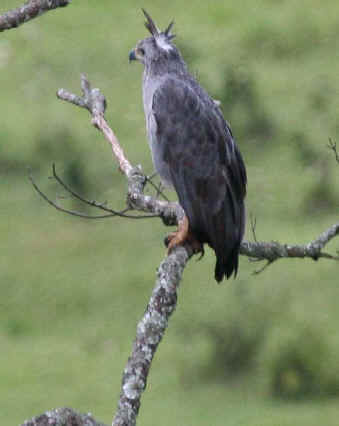
The Crowned Solitary Eagle,
showing the crown,
photographed during the FONT March 2008 Brazil Tour.
(photo by Marie Gardner)
57 RUFOUS-FACED CRAKE
______
Laterallus xenopterus
58 OLROG'S GULL _____
RS
Larus atlanticus
59 RUDDY PIGEON ______
AF
AM MT
Patagioenas subvinacea
60 SAPPHIRE QUAIL-DOVE ______
Geotrygon saphirina
61 GOLDEN-CAPPED PARAKEET ______ MN (BRe)
Aratinga auricapilla
The Golden-capped Parakeet is an attractive species restricted to forested areas
of southeast Brazil. Its decline is due to habitat fragmentation and trapping.
It is closely related to the Sun Parakeet of northern Brazil and the Jandaya
Parakeet of northeast Brazil.
The Golden-capped Parakeet has been seen during most FONT tours in Minas Gerais,
where the species is found in scattered areas. Outside Minas Gerais, there are
some recent records from several sites in Sao Paulo state, from single sites in
Rio de Janeiro and Parana states, and from two areas in Goias state. There have
been no records from Espiritu Santo state since 1950.
62 CRIMSON-BELLIED
PARAKEET ______ AF
Pyrrhura perlata
63 PEARLY PARAKEET ______
Pyrrhura lepida
64 BLUE-THROATED PARAKEET ______ (BRe)
Pyrrhura cruentata
65 SCARLET-SHOULDERED PARROTLET ______
Touit huetii
66 WHITE-BELLIED PARROT ______ AF
Pionites leucogaster
67 VULTURINE PARROT ______ AF
Pyrilia vulturina
68 FESTIVE AMAZON ______
Amazona festiva
69 YELLOW-FACED AMAZON ______ BR
Amazona xanthops
The Yellow-faced Amazon has been seen during FONT Brazil Tours near the
country's capital city of Brasilia.

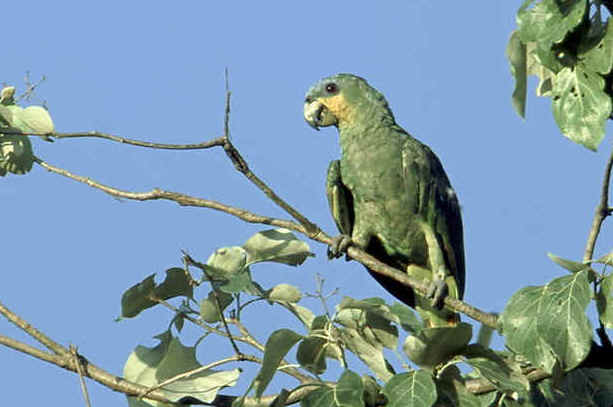
70 BLUE-BELLIED PARROT
______ (BRqe)
Triciaria malachitacea
71 SCALED GROUND-CUCKOO
______
Neomorphus squamiger
72 DOT-EARED COQUETTE
______ AF MT
(BRqe)
Lophornis gouldii
73 THREE-TOED JACAMAR ______
MN SE
(BRe)
Jacamaralcyon tridactyla
The Three-toed Jacamar
is a Brazilian endemic that has, during recent years, undergone a major decline in numbers, and a
contraction of range. Habitat clearance
has been mainly
responsible.
The population is now estimated to be from 250 to 1,000 birds.
The
species can continue in relatively small woodlots where there are mudbanks in
which to nest. The occurrence of this rarity is localized.
It has been seen during FONT
tours since 1997, mostly in
Minas Gerais, but most recently in 2011, in a remote part of Rio de
Janeiro
state, just a few kilometers from the Minas Gerais border.
74 BLACK-GIRDLED BARBET ______ AF MT
(BRe)
Capito dayi
75 WHITE-BELLIED PICULET ______
Picumnus spilogaster
76 OPAL-CROWNED MANAKIN ______
Lepidothrix iris
77 GRAY-WINGED COTINGA ______ (BRe)
Tijuca condita
78
BLACK-HEADED BERRYEATER ______ (BRe)
Carpornis melanocephala
79 CINNAMON-VENTED PIHA ______ ES
MN (BRe)
Lipaugus lanioides
80 BARE-THROATED BELLBIRD
______ ES IG SE (BRqe)
Procnias nudicollis
81 BLACK-CAPPED PIPRITES ______
SE (BRqe)
Piprites pileatus
82 BUFF-BREASTED
TODY-TYRANT ______ (BRe)
Hemitriccus mirandae
83 FORK-TAILED TODY-TYRANT ______
(BRe)
Hemitriccus furcatus
84 SAO PAULO TYRANNULET ______ SE
(BRqe)
Phylloscartes paulistus
85 BLACK-AND-WHITE MONJITA
______
RS
Heteroxolmis dominicana

A Black-and-white Monjita
photographed during a FONT tour in Rio Grande do Sul, Brazil
(photo by Marie Gardner)
86 COCK-TAILED TYRANT ______
BR MN MT (BRqe)
Alectrurus tricolor
With extensive and continuing habitat loss throughout its range, the
Cock-tailed Tyrant has had a rapid population decline. The favored habitat is seasonally wet
and dry grasslands. It remains locally common in a few scattered protected areas
in the Brazilian states of Minas Gerais and Goias. In the former, where we've
seen it during a number of FONT tours, in the Serra da Canastra National Park,
it has been said to be migratory, arriving in mid-August and departing by
January. However, we've also seen the species there, in numbers, during March,
most recently during our tour in that month in 2008.
Breeding is said to occur at the start of the wet season in September-October.
Only one time have we seen the species in Mato Grosso, in cerrado habitat in
Chapada dos Guimaraes.
A Cock-tailed Tyrant photographed during the March 2008 FONT Brazil Tour
at Canastra National Park in Minas Gerais.
(photo by Marie Gardner)
87 RONDONIA BUSHBIRD
______
Clytoctantes atrogularis
88 WHITE-BEARDED ANTSHRIKE ______
SE
Biatas nigropectus
89 PLUMBEOUS ANTVIREO ______ (BRe)
Dysithamnus plumbeus
90 SALVADORI'S ANTWREN ______ SE
(BRe)
Myrmotherula minor
91 UNICOLORED ANTWREN ______
SE (BRe)
Myrmotherula unicolor
92 GUIANAN STREAKED ANTWREN ______
Myrmotherula surinamensis
93 BAND-TAILED ANTWREN ______ (BRe)
Mymotherula urosticta
94 ASH-BREASTED ANTBIRD ______
Myrmoborus lugubris
95 BLACK-TAILED ANTBIRD ______
Myrmoborus melanurus
96 BARE-EYED ANTBIRD ______
Rhegmatorhina gymnops
97 STRIATED SOFTTAIL ______ (BRe)
Thripophaga macroura
98 PINK-LEGGED GRAVETEIRO ______ (BRe)
Acrobatornis fonsecai
99 CANEBRAKE GROUNDKEEPER ______
RS (BRqe)
Clibanornis dendrocolaptoides
The Canebrake Groundcreeper is a little-known species that occurs in small and fragmented
populations. Its range is only in southern Brazil (in the states of Rio Grande
do Sul, Parana, Santa Catarina, and southern Sao Paulo), and in southeast
Paraguay and in northeast Argentina. In the portions in that range in Argentina,
Paraguay, and Sao Paulo, Brazil, there have been very few records.
Most recent records of the bird have been in the Brazilian states
of Santa Catarina and Parana, But we saw the bird in the state of Rio Grande do
Sul (near Santa Catarina).
In the book "Threatened Birds of the World"
(a Birdlife International publication), it's stated that there have been
"no records in Rio Grande do Sul since
1973".
The bird is said to be rare in thickets and dense vine-tangles near streams
where deciduous and Araucaria forests meet. It was in such a habitat that we
found it during our October '06 tour.
100 UNIFORM WOODCREEPER
______
Hylexetastes uniformis
101 BRIGIDA'S WOODCREEPER (or MATO GROSSO WOODCREEPER) ______
Hylexetastes brigidai
102 HOFFMANN'S WOODCREEPER ______
Dendrocolaptes hoffmannsi
103 OCHRE-BREASTED PIPIT ______
MN (BRqe)
Anthus nattereri
104 PEARLY-BREASTED CONEBILL ______
AM
Conirostrum margaritae
105 BLACK-MASKED FINCH ______
MN
Coryphaspiza melanotis
106 CINEREOUS WARBLING FINCH
______
MN
(BRe)
Poospiza cinerea
107 BUFFY-FRONTED SEEDEATER ______
SE
(BRqe)
Sporophila frontalis
108 TEMMINCK'S SEEDEATER ______
SE
Sporophila falcirostris
Species in Brazil classified as NEAR-THREATENED:
109 SOLITARY TINAMOU ______
IG MN SE
(BRqe)
Tinamus solitarius
110 GREAT TINAMOU ______
AF MT
Tinamus major
111 WHITE-THROATED TINAMOU ______
Tinamus guttatus
112 YELLOW-LEGGED TINAMOU ______ MN (BRe)
Crypturellus noctivagus
113 GRAY-LEGGED TINAMOU ______
Crypturellus duidae
114 BLACK-CAPPED TINAMOU ______
Crypturellus atrocapillus
115 GREATER RHEA ______ MN
MS MT RS
Rhea americana
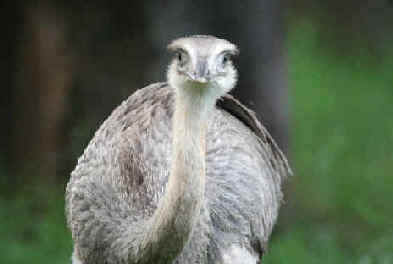
A Greater Rhea photographed
during a FONT tour in Brazil
116 CRESTLESS CURASSOW
______
Mitu tomentosum
117 MARBLED WOOD-QUAIL ______ AF MT
Odontophorus gujanensis
118 ORINOCO GOOSE ______
Neochen jubata
119 MAGELLANIC PENGUIN ______ RS SE
Amazona leucocephala
During recent years, the total population of the Magellanic
Penguin has been decreasing.
As of 2012, that population has been estimated as being 1.3 million
pairs, with 950,000 breeding along the coast of Argentina, at
least 100,000 in the Falkland (Malvinas) Islands, and at least
200,000 nesting in Chile.
In Argentina, there are just over 60 sites where Magellanic Penguins
breed.
In Chile, there are at least 10 locations.
Recent population trends have been different at various colonies.
The two largest colonies in Argentina have had decreases during the last
decade, but other smaller colonies have grown.
Outside their breeding season, Magellanic Penguins migrate north to the coast
and offshore waters of Brazil.
During FONT Brazil Tours, they have been
seen in Rio Grande do Sul and near Ubatuba in Sao Paulo state.
Magellanic Penguins, tracked by satellite and GPS sensor tags
during their breeding season, have been found to typically forage more than 100
kilometers from their nesting sites, and sometimes, at various colonies in Argentina,
as much 600 kilometers from the sites.
Individual Magellanic Penguins show a high site fidelity, with nearly all
birds returning to the colony in which they were born, and with most adults
using the same burrow year after year.
As vagrants, Magellanic Penguins have occurred as far north (in the
Pacific Ocean) as El Salvador in 2007, and south to Avian Island on the Antarctic
Peninsula, and also as far away as New Zealand and Australia.

A Magellanic Penguin
photographed
during a FONT Brazil Tour in Rio Grande do Sul
120
BLACK-BROWED ALBATROSS ______
RS
Thalassarche (has been
Diomedea) melanophrys
Black-browed Albatrosses have been seen from shore during
FONT Brazil Tours in Rio Grande do Sul.
121 ZIGZAG HERON ______
AF
MT
Zebrilus undulatus
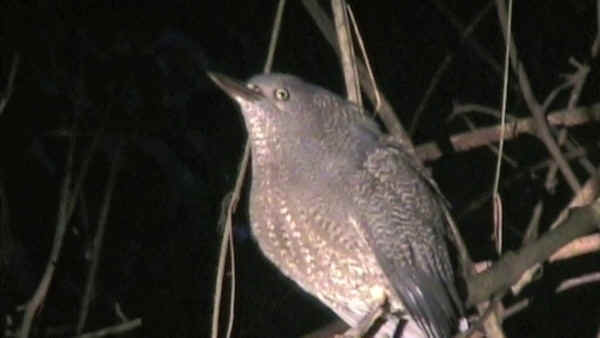
Zigzag Heron
(photo by Frank Stermitz)
122 ORANGE-BREASTED FALCON ______
MS
MT
Falco deiroleucus
123 GRAY-BELLIED HAWK ______ MN SE
Accipiter poliogaster
124 MANTLED HAWK ______ MN SE (BRqe)
Leucopterbis polionotus
The Mantled Hawk is rare and local in lowland and mid-elevation forests of
eastern Brazil from Alagoas south to Rio Grande do Sul. It is nearly endemic to
Brazil, with only very few in adjacent Uruguay, and just one record recently in
Paraguay. Deforestation and agricultural practices have been cited as causes for
the species' decline.
125 HARPY EAGLE ______
AF AM MT
Harpia harpyja
The Harpy Eagle has been seen
during a half a dozen FONT tours in the Brazilian state of Mato Grosso, and also
in the state of Amazonas.
Our first sighting of this massive raptor was back in August 1993 in the northern
part of Mato Grosso in the area of the Rio Cristalino north of Alta Floresta. The
bird was at a nest in a huge tree in the forest. 2 years later, in August 1995,
during a boat-trip along the river, an adult Harpy Eagle was observed perched in
a big dead tree by the river, just prior to 2 younger birds being seen flying
about, nearby, upriver. Photos were taken.
Later, in 1998, 2000, and during 2 tours in 2004, Harpy Eagle were
observed at and near a nest, with young, during FONT tours in southern
Mato
Grosso state, at Serra das Araras.
In 2004, a young bird (already big) was seen at that nest during our tour in
August. Two months later, in October, during another FONT tour, that same bird
was seen again. The bird was still by the nest (and it was even bigger). Its
loud call could be heard a long distance away, as it begged for food.
One of the adults, during the October 2004 tour, was seen nearby, flying not far
above the canopy of the forest.
In Amazonian Brazil, during our February 2010 tour, an adult
Harpy Eagle was perched high in a tall tree by one of the tributaries of the
Amazon on the south side of the big river.
The Harpy Eagle is sparsely distributed throughout its extensive range in
Central & South America.
It has been extirpated in a large part of its
former range, particularly in the north in central & northern Central
America, and in the south in northern Argentina and southern Brazil.
The species occurs in interrupted expanses of lowland tropical forest. The low
overall population and a slow reproductive rate make shooting a significant
threat.

An immature Harpy Eagle
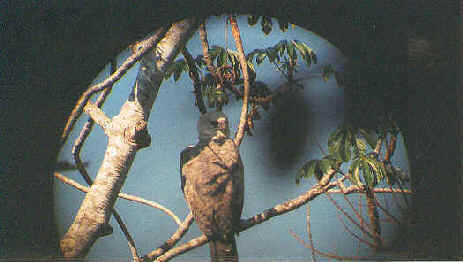
Another young Harpy Eagle, photographed through a telescope,
during a FONT tour in Mato Grosso, Brazil
THE FOLLOWING IS FROM NOTES WRITTEN BY ARMAS HILL
RELATING TO ONE OF HIS EARLY TRIPS IN BRAZIL IN THE 1980s:
"From the area of the city of Belem, near the
mouth of Amazon River, two of my remembrances are still vivid years
later.
One, as I walked along a trail in the jungle, is of an agitated
Amazonian Royal Flycatcher up in the tree with its orange erect crest.
The bird was agitated as there was a snake moving on a nearby branch.
And secondly, when I was at the zoo in Belem, I saw closely my
first Harpy Eagle. That captive bird was big, granted, but what
struck me the most at the time, and I can still remember in my mind, were its huge
talons and massive claws. I had never seen such things, and seeing
them closely made an impression that I've never forgotten."
The Harpy Eagle is the biggest raptor in the Americas and the most
powerful in the world.
The massive claws of the Harpy Eagle are more powerful than those
of virtually every other bird. They can pierce the skull of a monkey or a
sloth, the bird's main prey.
Although the large Harpy Eagle often seems docile and doesn't seem to
move much, when it does it can move between tree branches at up to 80 kilometers
(about 50 miles) an hour during one of its almost silent and often lethal
hunting flights.
Female Harpy Eagles are over a meter (3.3 feet) in length and weigh as
much as 10 kilograms (22 pounds). They can lift prey weighing more than 12
kilograms (26 pounds) with little effort, tear it to pieces and carry it back to
the nest.
There, at the nest, the adult feeds the morsels to its single chick.
One chick is raised every 2 and half years. The juvenile stays in its
parent's territory during that period, and will breed itself after 6 years.
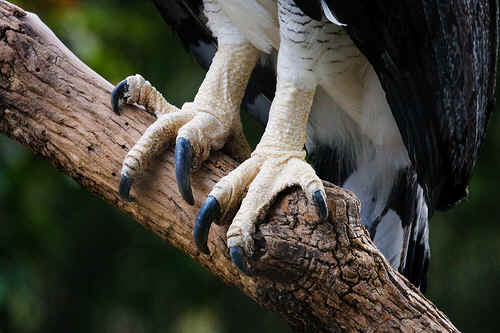
Above: the massive claws of a
Harpy Eagle
Below: the orange erect crest of the Royal Flycatcher

126 CRESTED EAGLE
______
Morphnus guianensis (the only
member of its genus)
127 ORNATE HAWK-EAGLE
______ AF MN MS MT SE
Spizaetus ornatus
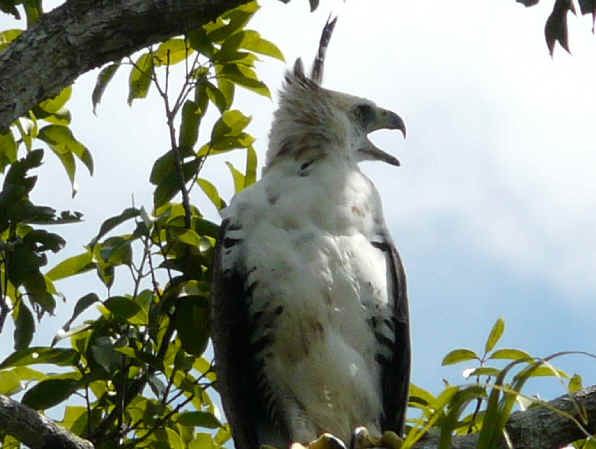
Ornate Hawk-Eagle
128
BLUE-WINGED MACAW (also called
ILLIGER'S MACAW) ______ BR
IG MN MT (BRqe)
Primolius (formerly
Propyrrhura) maracana
129 BLACK-CAPPED PARAKEET
______
Pyrrhura rupicola
130
CAICA PARROT ______
Pyrilla caica
131
ORANGE-CHEEKED PARROT ______
Pyrilla barrabandi
132
ORANGE-HEADED PARROT (also called the BALD PARROT) ______
(BRe)
Gypopsitta aurantiocephala
Although just recently described in 2002,
the Orange-headed Parrot has had, during that short time it's been known,
2 English common names. It's also been called the Bald Parrot.
The species has also had, during that short time, 2 scientific names. It was
first called "Pionopsitta aurantiocephala", but has since been
put in the new genus Gypopsitta, in which it is the only member.
It is unusual, to be sure, that such a large and colorful bird could have gone
undetected for as long as it did. But actually it was noticed as it had been
assumed to be the immature Vulturine Parrot, Pionopsitta vulturina,
seen flying in flocks separated from adults.
The Orange-headed Parrot occurs only in Brazil, in the lower Madeira and
upper Tapajos River valleys, and particularly along the Sao Benedito and Cururu
tributaries of the Teles Pires River. It seems to favor gallery forest and
"campinarana" white sand soil forest (as near the Thaimacu Lodge, and
by the Serra de Cachimbo as can be seen from the Cuiaba-Santarem Road).
To Tony Juniper, one of the authors of "A Guide to the Parrots of the
World", the discovery of the Orange-headed Parrot was quite
significant, as he said: "I think these days the discovery of any new
species is a red-letter day ... as (shown by this bird) a species could possibly
go extinct without ever having been noticed".
133 KAWALL'S AMAZON (also called WHITE-CHEEKED
AMAZON) ______ AF (BRe)
Amazona kawalli
What has been known as the "Kawall's Parrot", or Kawall's
Amazon, (also called the White-cheeked Amazon) was described in 1989,
from a single caged bird that was noticed in the Brazilian city of Sao Paulo.
This large parrot was later found to be widespread across much of southern
Amazonia, where it was first seen in the wild in 1996.
It was obviously overlooked, and apparently so simply because it was not known
to exist and because it so resembled the common Mealy Amazon.
134 RUSTY-BARRED
OWL ______ MN SE (BRqe)
Strix hylophila
135 BAHIAN NIGHTHAWK
(also called PLAIN-TAILED NIGHTHAWK) ______ (BRe)
Nyctiprogne vielliardi
136 LONG-TRAINED NIGHTJAR ______
SE
(BRqe)
Macropsalis creagra
137 SICKLE-WINGED NIGHTJAR
______ MN
Eleothreptus anomalus
The Sickle-winged Nightjar, throughout its range, is generally scarce. There are
apparently fragmented populations in central and southeast Brazil. Outside
Brazil, the species has been found rarely in eastern Paraguay and northern
Argentina. Nearly all records have been of lone individuals, and many times
there has been only a single record at a particular locality. Some records have
been of southern breeders migrating north in the austral winter (May-Aug).
Habitats where the bird has been found include: gallery forest, chaco-woodlands,
cerrado, grasslands, savannas, marshlands, and swamps.
The species was seen during the FONT tour at Serra da Canastra National Park in
Minas Gerais state in October 2006.
138 SAW-BILLED HERMIT
______ SE (BRe)
Ramphodon naevius
The Saw-billed Hermit is the largest of the South American hummingbirds known as
hermits. Others have longer tails, but in terms of weight, this is the biggest.
Its length is 15 centimeters. Only one other hermit, with a longer tail, has a
greater length - the Great-billed Hermit of northern Brazil and the Guianas has
a length of 16 centimeters.
The Saw-billed Hermit only occurs in southeastern Brazil, where it is relatively
common in lowland Atlantic forest and in nearby second growth. The species is
considered "near-threatened" by Birdlife International as its overall
population can be adversely affected by deforestation and agricultural
conversion.
We've seen the Saw-billed Hermit during FONT tours in the Ubatuba area, and,
recently, the species was enjoyed when during our March 2008 tour, we birded at
the Fazenda Capricorno, located on the Tropic of
Capricorn.
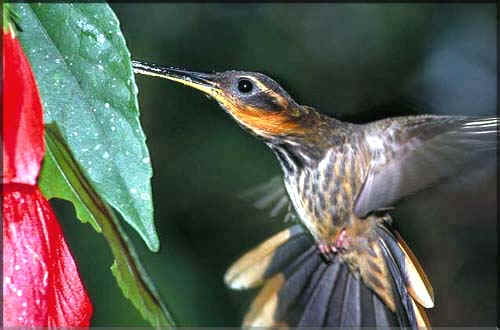
Saw-billed Hermit
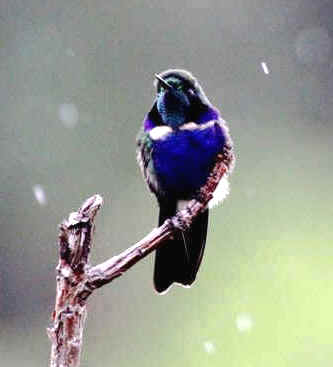
A Hyacinth Visorbearer
photographed during a FONT tour
140 RED-NECKED ARACARI ______
AF MT
Pteroglossus bitorquatus
141 SAFFRON TOUCANET ______ IG SE
(BRqe)
Baillonius bailloni
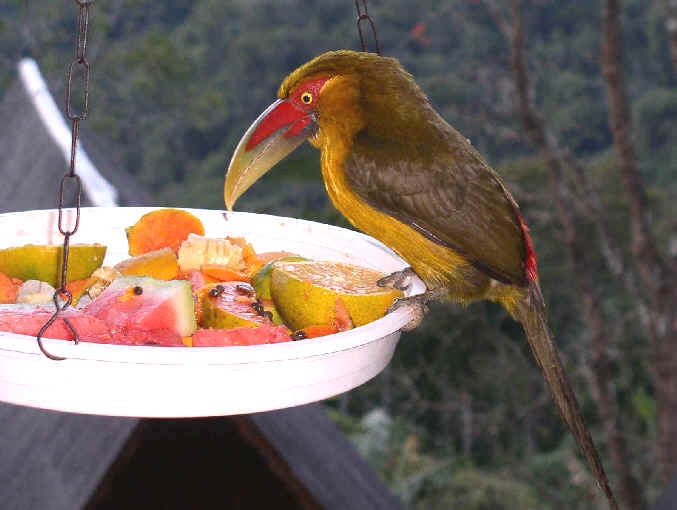
A Saffron Toucanet at a
feeder in southeast Brazil,
having breakfast as we were during a FONT tour.
142 MOTTLED PICULET ______
RS
Picumnus nebulosus
143 GUIANAN PICULET ______
Picumnus minutissimus
144 YELLOW-BROWED WOODPECKER ______
RS MN SE
(BRqe)
Piculus aurlentus
145 SWALLOW-TAILED COTINGA ______
MN SE (BRqe)
Phibalura flavirostris
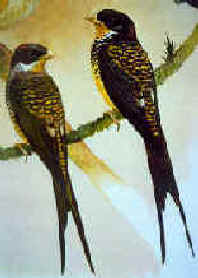
The Swallow-tailed Cotinga has
been a favorite
during FONT tours in southeast Brazil
146 WHITE-TAILED COTINGA ______
Xipholena lamellipennis
147 BLACK-AND-GOLD COTINGA ______ SE (BRe)
Tijuca atra
The Black-and-gold Cotinga is a Brazilian endemic with a very limited range,
occurring from 1,000 to 2,000 meters above sea level in Rio de Janeiro state,
extreme eastern Sao Paulo state, and adjacent Minas Gerais state, where it is
occurs in montane Atlantic Forest. It is found in the canopy and the middle
level of the forest, where it makes its distinctive, unusual call.
The Black-and-gold Cotinga has been seen during FONT tours in Southeast Brazil
in more than one of the areas favored by the bird,
148 HOODED BERRYEATER
______
ES SE (BRe)
Carpornis cucullatus
149 HANGNEST TODY-TYRANT ______ MN
SE (BRe)
Hemitriccus nidipendulus
150 EYE-RINGED TODY-TYRANT ______
MN SE (BRe)
Hemitriccus orbitatus
151 GRAY-CAPPED TYRANNULET ______
MN SE (BRe)
Phyllomyias griseocapilla
152 SHARP-TAILED GRASS TYRANT ______ BR
MN
Culicivora caudacuta
153 GRAY-BACKED TACHURI ______ MN (BRe)
Polystictus superciliaris
154 SOUTHERN BRISTLE-TYRANT ______
IG SE (BRqe)
Phylloscartes eximius
155 OUSTALET'S TYRANNULET
______ SE (BRe)
Phylloscartes oustaleti
156 SERRA DO MAR TYRANNULET ______
SE (BRe)
Phylloscartes difficilis
157 CHAPADA SUIRIRI ______ MT
Suiriri islerorum
The Chapada Suiriri was recently
described, in 2001.
158 OLIVE-SIDED FLYCATCHER
______ AM
Contopus cooperi
159 CASTELNAU'S ANTSHRIKE ______
Thamnophilus cryptoleucus
160 SPOT-BREASTED ANTVIREO ______ SE
Dysithamnus stictothorax
161 BROWN-BELLIED ANTWREN ______
Myrmotherula gutturalis
162 RUFOUS-TAILED ANTBIRD ______ SE (BRe)
Drymophila genei
163 OCHRE-RUMPED ANTBIRD ______
MN SE (BRe)
Drymophila ochropyga
164 RIO DE JANEIRO ANTBIRD ______ SE (BRe)
Cercomacra brasiliana
165 GUIANAN WARBLING ANTBIRD ______
Hypocnemis cantator
166 WHITE-LINED ANTBIRD ______
Percnostola lophotes
167 WHITE-BREASTED ANTBIRD ______
Rhegmatorhina hoffmannsi
168 SPOTTED BAMBOOWREN ______ SE (BRqe)
Psilorhamphus guttatus
169 SLATY BRISTLEFRONT ______
SE
(BRe)
Merulaxis ater
170 BRASILIA TAPACULO ______
MN (BRe)
Scytalopus novacapitalis
The Brasilia Tapaculo is similar to a number of other small, black tapaculos, in
that it haunts then undergrowth. This species, however, is endemic to central
Brazil, where it is rare and local.
During FONT tours, we've had some good looks at this little denizen, since our
first, which was in the Serra de Canastra National Park, in March 1997.
171 WHITE-BREASTED
TAPACULO ______
MN SE
Eleoscytalus
(formerly Scytalopus) indigoticus
172 CAMPO MINER ______ MN MT
Geobates poecilopterus
173 ARAUCARIA TIT-SPINETAIL ______
RS SE
Leptasthenura setaria
174 LONG-TAILED CINCLODES ______
RS
(BRe)
Cinclodes pabsti
The Long-tailed Cinclodes is a Brazilian endemic restricted to a very
limited range in the southern part of the country, in northeast Rio Grande do
Sul and southeast Santa Catarina states.
It was described to science as recently as 1969, by the prominent Brazilian
ornithologist Helmut Sick.
All of the other cinclodes occur in South America in the Andes and
Patagonia. The most widespread member of the genus, the Bar-winged Cinclodes,
also occurs in the Brazilian state of Rio Grande do Sul, but only during the
austral winter.
There is no estimate of the population of the Long-tailed Cinclodes, but
the species, overall, is not common, and it is believed to be declining at a
moderately rapid rate due to habitat loss. Up to 60 per cent of the grassland
habitat in the bird's range has been converted to pine plantations.
It appears that the species can persist for about 2 years in an area after it
has been planted with pines, but it is displaced by the time the trees reach 7
meters in height.
The following commentary about the Long-tailed Cinclodes is from a book written
by Helmut Sick, a classic entitled "Birds in Brazil".. It was
translated into English in 1993.
"The Long-tailed Cinclodes is one of the largest of the
furmariids (ovenbirds). It can remind one of a Chalk-browed
Mockingbird."
(And that it did when we found the bird during the FONT Tour in Rio
Grande do Sul in October 2010! And the mockingbirds were also in the vicinity.)
Continuing with Mr. Sick's description:
"The posture (of the Long-tailed Cinclodes) is erect, its legs
strong, it's tail long.
It nests in Rio Grande do Sul from September to November, and overnights in
galleries excavated in embankments. In such holes, the eggs are placed on a
lining of grass and feathers.
The species is less dependent on the presence of water than other cinclodes.
The bird walks and runs on the ground, and perches on posts and rocks or stone
fences.
It flies well, but it does not migrate."
Although now isolated, and never coming in contact with other cinclodes,
the Long-tailed Cinclodes is most closely related to, and is considered
a superspecies with Cinclodes fuscus, the Bar-winged Cinclodes
and Cinclodes comechingonus, the Cordoba Cinclodes, a localized
species endemic to mountains in north-central Argentina.
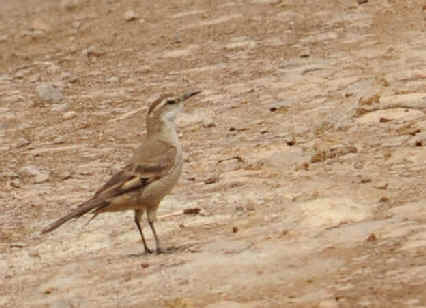
A Long-billed Cinclodes
photographed during the
FONT Brazil Tour in Rio Grande do Sul, in October 2010
(photo by Bob Enever)
175
CHESTNUT-THROATED
SPINETAIL ______ AF
Synallaxis cherriei
176 CABANIS' SPINETAIL ______
Synallaxis cabanisi
177 WHITE-BROWED FOLIAGE-GLEANER ______ MN
SE
Anabacerthia amaurotis
178 GRAY-THROATED LEAFTOSSER ______
Sclerurus albigularis
179 LONG-TAILED WOODCREEPER ______
AF
AM
Deconychura longicauda
180 ZIMMER'S WOODCREEPER ______ AM
Dendroplex kienerii
181 AZURE JAY ______
RS (BRqe)
Cyanocorax caeruleus
182 TOOTH-BILLED WREN ______
AF
Odontorchillus cinereus
183 CREAMY-BELLIED GNATCATCHER ______
SE
Polioptila lactea
184
GREEN-CHINNED
EUPHONIA ______ IG
MN SE
Euphonia chalybea
185 AZURE-SHOULDERED TANAGER ______
ES RS SE
(BRe)
Thraupis cyanoptera
186 SHRIKE-LIKE TANAGER
______
BR MT
Neothraupis fasciata
187 BROWN TANAGER ______
ES MN SE (BRe)
Orchesticus abeillei
188 BLACK-LEGGED
DACNIS ______
Dacnis nigripes
189 BICOLORED CONEBILL ______ SE
Conirostrum bicolor
190 BLUE FINCH ______
MN MT
(BRqe)
Porphyrosspiza caerulescens
191
DARK-THROATED SEEDEATER ______
MT
Sporophila ruficollis
192 COAL-CRESTED FINCH ______ BR
MN MT
Charitospiza eucosma
193 SERRA FINCH ______ MN
(BRe)
Embernagra longicauda
194 RED-AND-BLACK GROSBEAK ______
Periporphyrus erythromelas
References:
Threatened Birds of the World (a Birdlife International publication), Lynx Ediciones, 2000, and "recently recategorized species" since then, through 2014.